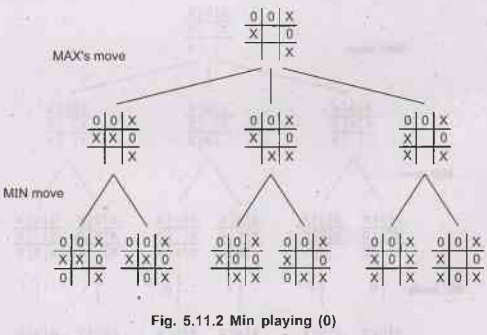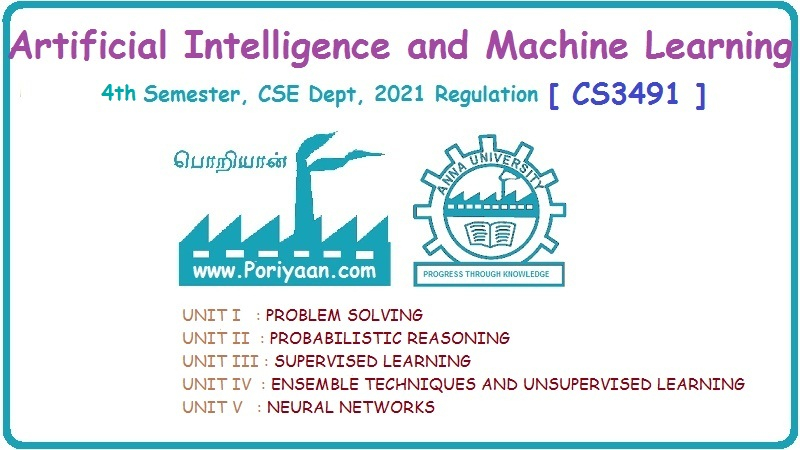Artificial Intelligence and Machine Learning: Unit I(e): Adversarial search
Min-Max Algorithm
Adversarial search - Artificial Intelligence and Machine Learning
The minimax algorithm computes the minimax decision from the current state. It is used as a searching technique in game problems. The minimax algorithm performs a complete depth-first exploration of the game-tree.
Mini-Max
Algorithm
AU:
Dec.-03, 04, May-09, 10, 17, 19
The
minimax algorithm computes the minimax decision from the current state. It is
used as a searching technique in game problems. The minimax algorithm performs
a complete depth-first exploration of the game-tree.
Concept of Mini-Max Algorithm
1.
The start node is MAX (player 1) node with current board configuration.
2.
Expand nodes down (play) to some depth of look-ahead in the game.
3.
Apply evaluation function at each of the leaf nodes.
4.
"Back up" values for each non-leaf nodes until computed for the root
node.
5.
At MIN (player 2) nodes, the backed up value is the minimum of the values
associated with its children.
6.
At MAX nodes, the backed up value is the maximum of the values associated with
its children.
Note The process of "backing up" values gives the optimal
strategy, that is, both players assume that your opponent is using the same
static evaluation function as you are.
Properties of Mini-Max
1.
Minimax provides a complete solution for finite tree.
2.
Minimax provides optimal strategy against an optimal opponent.
3.
The time complexity is O(bm).
4.
The space complexity is O(bm) for depth-first exploration where
algorithm generates all successor at once, or O(m) for an algorithm that
generate successors one at a time.
Problem Associated with Mini-Max
This
algorithm explores whole search space. If we have a game with huge search
spaces it will take long time.
In
such cases then exact solution is completely infeasible.
Game Playing with Mini-Max-Tic-Tac-Toe [Noughts and crosses] Example
1.
Assume that two players named MIN and MAX who are playing the game.
2.
MAX is playing first.
3.
As you can see initially MAX has nine possbile moves.
4.
Play alternates between MAX and MIN until we reach leaf nodes corresponding to
terminal states such that one player has 3 in a row or all the squares are
filled.
5.
The number on each leaf node indicates the utility value of the terminal state
from the point of view of MAX.
6.
High values are assumed to be good for MAX and bad for MIN.
7.
It is MAX's job to make use of search tree to determine best move.
8.
Static evaluation. Criteria + 1' for a win, '0' for draw.
Example to show how Mini-Max Algorithm Works
Consider
game of tic-tac-toe with the initial state -
Step
1:

Start: MAX (player 1) moves (MAX is making X)

Step
2: Next: MIN (player 2) moves.

Step
3: Again: MAX's moves

Step
4: +1' for a win, '0' for a draw. Criteria '+ 1' for a win, '0' for
a draw.

Step
5: Level by level, on the basis of opponents turn UP: One level

Step
6: UP: Two levels

Step
7: Choose best move which is maximum

The 'made-up' Games and Concept of 'ply'
For
study purpose we can form a game a tree which is constructed up to certain
level (i.e. upto certain depth). This is called as a made-up game. The term ply
refers to depth of the tree.
For
example - ply 4 is level at depth 4 below the root node.
Example
A
two ply game tree, for game of tic-tac-toe.
1.
Assume that two players named MIN and MAX who are playing the game.
2.
MAX is playing first.
3.
The possible moves for MAX at the root node are labeled a1, a2 and a3.
4.
The possible replies to a 1 for MIN are b1, b2, b3 and so on.
5.
This particular game ends after one move each by MAX and MIN.
6.
In game parlance, we say that this tree is one which, moves deep consisting of
two-half-moves, each of which is called a ply.

Example
A
three-ply game tree, for game of tic-tac-toe

Mini-Max Algorithm for Playing Multiplayer Games
1.
There are many multiplayer games like cricket, football, etc.
2.
The multiplayer game can be played with minimax concept.
3.
Here the single value for each node is replaced with a vector of values. For
example, in a three-player game with players A, B, and C a vector (VA
, VB , VC) is associated with each node.
4.
For terminal states, this vector gives the utility of the state from each
player's viewpoint. (In two player, zero-sum games, the two-element vector can
be reduced to a single value because the values are always opposite.
5.
In this implementation UTILITY function return a vector of utilities.
6.
For non-terminal states we can calculate utility function value as explain
below - Consider following diagram,

7.
For non-terminal states vector values should be calculated as explained.
Consider the node marked X in the game tree shown in above diagram. In this
state, player C choose what to do. The two choices lead to terminal states with
utility vector (VA = 1, VB = 2, VC = 6) and
(VA = 4, VB = 2, VC = 3). Since 6 is bigger than 3, C should
choose the first move. This means that if state X is reached subsequent play
will lead to a terminal state with utilities
(VA = 1, VB = 2, VC = 6).
Hence the backed-up value of X is this vector.
8.
In general, the backed-up value of a node 'n' is the utility vector of
whichever successor has the highest value for the player choosing at 'n'.
Artificial Intelligence and Machine Learning: Unit I(e): Adversarial search : Tag: : Adversarial search - Artificial Intelligence and Machine Learning - Min-Max Algorithm
Related Topics
Related Subjects
Artificial Intelligence and Machine Learning
CS3491 4th Semester CSE/ECE Dept | 2021 Regulation | 4th Semester CSE/ECE Dept 2021 Regulation
